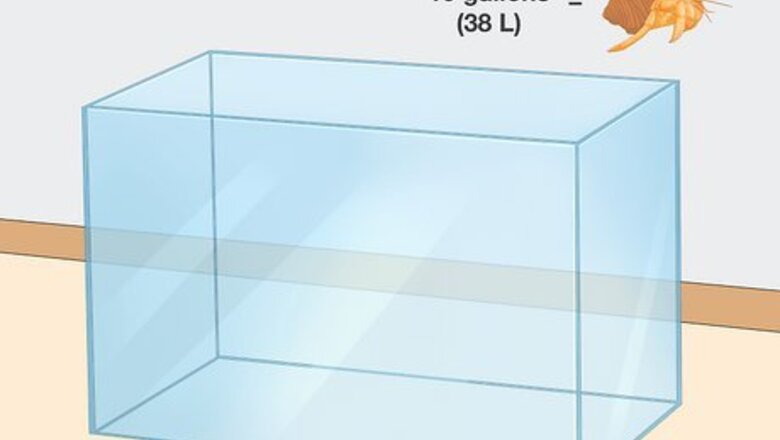
views
- Provide a tank with 10 gallons (38 L) worth of space per crab.
- For land crabs, fill the tank with a 5:1 ratio of play sand to EcoEarth. Put logs, rocks, fake plants, and 3-5 larger empty shells per crab in the tank.
- Fill one bowl with freshwater and one with salt water made with marine salt. Only use water that is chlorine-, chloride-, and ammonia-free.
Land Hermit Crab Habitats
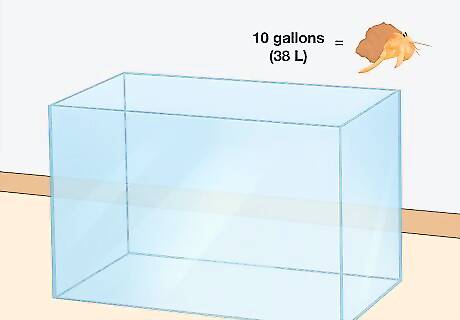
Get a glass tank that has at least 10 gallons (38 L) of space per crab. The little containers hermit crabs are often sold in are too cramped—crabs need horizontal room to crawl and vertical room to burrow and climb. Small crabs (roughly 1 to 2.9 cm (0.39 to 1.14 in)) need at least 5 US gal (19 l) of space, medium and large crabs (3 to 6.9 cm (1.2 to 2.7 in)) need at least 10 US gal (38 l) each, and any larger crab needs 15 US gal (57 l). Hermit crabs are social animals, so consider getting two to keep each other company. The crabs need to be the same species, however, so they can communicate. Depending on the size of your hermit crabs you may need more or less space, so consult this sizing chart before buying your tank. Aquariums can get pretty pricey, but are often available secondhand. Look in “buy nothing” or marketplace groups online. Buy aquariums with glass lids (not mesh lids) or get a piece of plexiglass cut to size. Many hardware stores will cut it for free. Don’t leave any openings in the lid; the tank needs to be completely sealed. Some people cover their lids with plastic wrap, but it’s not the most efficient way to keep in humidity.

Fill the bottom of the tank with a play sand-EcoEarth substrate. Mix play sand and EcoEarth together in a 5:1 ratio. When the consistency is right, you should be able to make a sand castle out of the mix. Pour at least 6 in (15 cm) (or 4x as tall as your largest crab) of substrate into the tank. Make sure that your substrate is depth is 2 in (5.1 cm) more than the size of your largest hermit crab. Burrowing is a common and necessary behavior for hermit crabs, so they need enough substrate to be able to do this. Buy play sand from a hardware store, and not the "hermit crab" sand often found in pet stores. “Hermit crab sand” isn't good to use—in general, hermit crab substrate needs to be moist, while hermit crab sand is very dry. Hermit crab sand also has a super fine consistency, which isn't ideal since it can stick to a hermit crab's abdominal region (which is damp). Sterilize your sand by putting it in a large bucket and pouring boiling water over it. Mix the sand in the water, then let it sit for five minutes. Rinse the sand until the water runs clear, then put it on a baking sheet and heat it at 180 °F (82 °C) for half an hour. The 5:1 ratio is one 50 lb (23 kg) bag of play sand to ½ block of EcoEarth per each 10 gallons (38 L) of room in a tank. Let the EcoEarth dry completely before putting it in the tank. Wet substrate can cause mildew and bacterial blooms. Only ever use water that’s chlorine-, chloride-, and ammonia-free when hydrating EcoEarth (or doing anything with hermit crabs, for that matter). You can either buy distilled water, or use a water conditioner to remove any impurities.
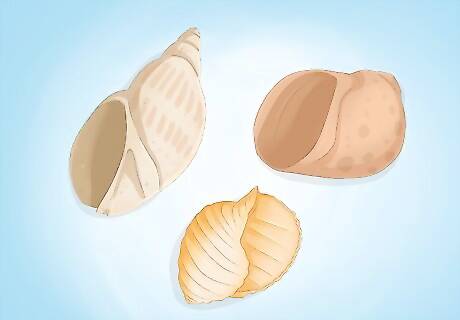
Keep 3-5 large empty shells per crab in the tank at all times. As crabs molt they outgrow their old shells and need to find new ones. By having a variety of shells available to them, they’ll be able to find the most comfortable fit. Don’t use painted shells; while they may be cute, they can be toxic to your crab.
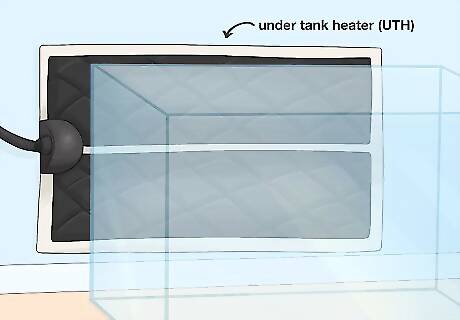
Install a heat pad on the back of the aquarium. Use an under tank heater (UTH) the same length as the longest side of your tank. Stick the UTH over the entire back wall of the tank, just above the substrate. This heats the air while leaving the sand cool. Many sites will tell you to put the UTH under your tank, but that can be dangerous for molting crabs. Hermit crabs dig all the way to the bottom of the tank to molt, and if they end up molting on the heat mat they’ll get burned.
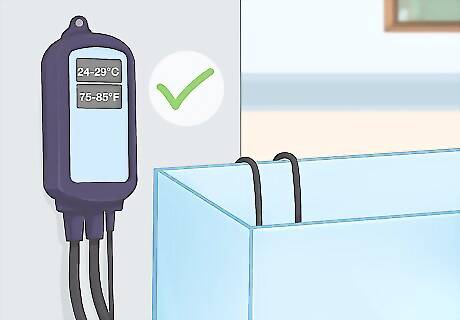
Keep the tank temperature between 75 to 85 °F (24 to 29 °C). Monitor the temperature with a thermometer, and adjust the heater as needed. The easiest way to keep the temperature consistent is with a thermostat connected to your heater. Your hermit crabs can tolerate brief dips in temperature, but extended periods of cold can make your crabs sick. One way to keep the tank a consistent temperature is by putting it in a stable area, away from vents, drafts, and direct sunlight. Consider getting a thermometer/hygrometer.
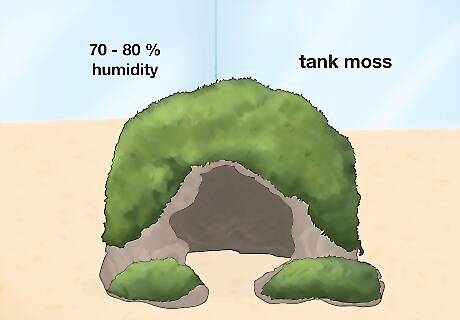
Keep the humidity between 70 and 80 percent at all times. To keep humidity in, use a completely sealed tank. Opening the lid to give them food and water lets enough oxygen in to keep them healthy. Install a hygrometer in the tank and monitor humidity daily. Putting tank moss in with your crabs boosts humidity and gives them something to climb on. Don't use sponges to raise humidity—they harbor bacteria and can make you and your hermit crabs sick. The only safe way to use sponges is to change and sterilize them every day.
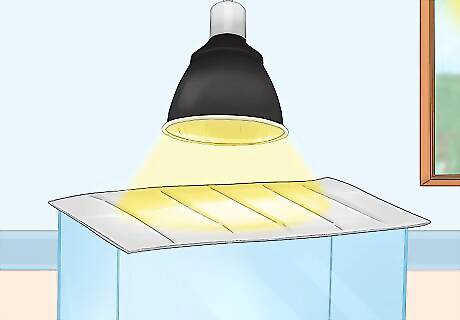
Keep your crabs on a 12-hour cycle of light and darkness. Put your tank in a location that exposes crabs to a standard light cycle, or install overhead lights. Some light bulbs can heat up the area underneath them, so use LEDs to not create a hotspot. Keep a plastic or glass barrier between the bulbs and the tank (like the lid). Don't set the tank in direct sunlight. Glass tanks trap the sun’s heat and can get too hot very quickly, which can cause your crabs to get sick or burnt. If your crabs get sufficient daytime light, you can skip the tank lights.
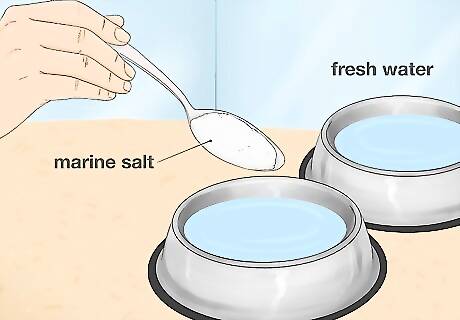
Place a fresh water dish and a marine salt water dish in the bowl. Give your crabs one dish of marine salt water and one of fresh water, both deep enough for the crabs to totally submerge themselves in. Use marine grade salt to mix your salt water, and use water conditioner to get rid of any chlorine, chlorides, heavy metals, or ammonia. Most marine grade salt requires ½ cup (144 g) per 1 US gal (3.8 L) of water, but check the instructions on your product for the specific ratio. Put things in your dishes to give smaller crabs a way to get out, like glass marbles or river stones. Each dish needs to be at least as deep as your largest crab is tall. Paint trays, glass containers, and hermit crab pools are all great options.
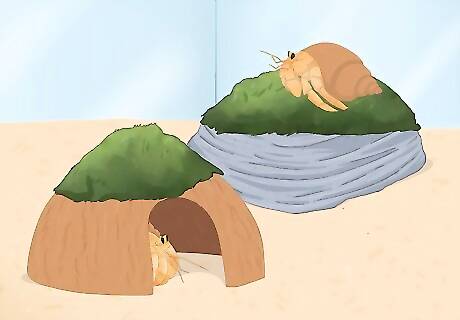
Fill the tank with objects for the crabs to hide under and climb on. Give your hermit crabs shelter and entertainment by filling the entire bottom of the tank with logs, fake plants, rocks, bark, bridges, and toys. Crabs love to climb, so make sure everything with a lot of height is firmly secured so nothing falls and hurts one of your crabs. Add cholla wood (dried cactus),cork log, coral, and moss to climb on. Add ladders, bridges, and crawling wheels, but you can also DIY your own decor. Here are a few ideas: Make a climbing net. Hermit crabs love to climb—you can find them up in the trees in their natural habitats! Give them a net to climb on by folding up cheesecloth until it’s a little smaller than the base of the tank. Attach suction cups with hooks at each corner, then attach the net to the sides of the tank.
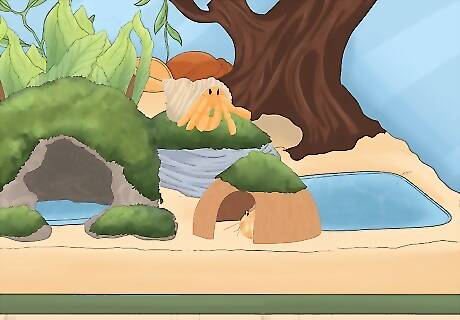
Style your tank after your crab’s natural environment. Hermit crabs are prey animals, so they don’t feel safe in open spaces. To get your hermit crabs to be more comfortable and active, put the objects all over the tank and not just against the back wall: the more cluttered the better. Your crabs should be able to hide anywhere at any time. Think about items you may find in the forest or on the beach—shells, rocks, coral, bones, plants, etc. Fill your tank with leaves, twigs, and logs. Making your enclosure look like the forest floor will add an interesting touch to any room it’s displayed in, as well as providing your crabs with a comfortable environment to hide in. Crabs will be more comfortable in an environment they can recognize. Put plants (or plastic plants) native to tropical environments into the substrate for them to climb on. You can put live plants in with hermit crabs, but there’s a high chance the crabs will kill them. Keep conifers (think pine, cedar, etc.) and metal out of your crab’s tank.
Marine Hermit Crab Habitat
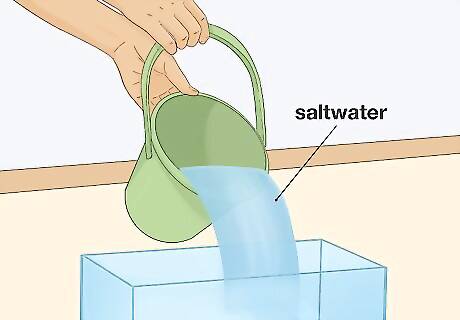
Add hermit crabs to an existing aquarium, or fill a tank with saltwater. Marine hermit crabs are scavengers and can happily survive in any healthy tank. Start new tanks with chloride, chlorine, and ammonia free saltwater. Mix the water with marine grade salt outside of the tank, then wait for the salt to dissolve completely before adding it in. Once again, get at least 10 US gal (38 L) of space per crab you have that’s smaller than 7 centimetres (2.8 in), and get 15 US gal (57 L) for any larger crab. Many pet stores sell pre-mixed saltwater. Give your crabs several inches of sand to burrow in. Hermit crabs love to dig and need to burrow in the sand when they’re molting. Make the sand four times as deep as your largest crab is tall. Use a calculator to figure out how much sand your tank needs. For example, a standard 30 gallon breeder tank needs 216 lb (98 kg) of sand to have 5 in (13 cm) of digging room. Wash your sand with boiling water and bake it at 180 °F (82 °C) for half an hour before putting it in the tank.
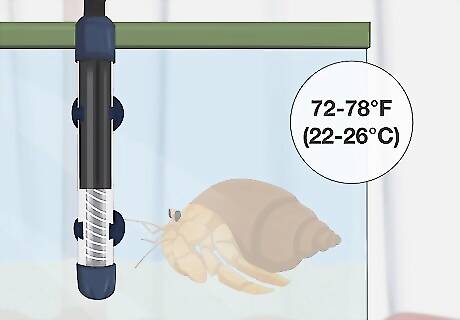
Heat the water to 72 and 78 °F (22 and 26 °C). Find out what species of crab you have so you can match the temperature to the crab’s natural environment. Generally, crabs need water that’s between 72 and 78 °F (22 and 26 °C). Use an aquarium heater with a thermostat to keep the temperature consistent. Keeping a thermometer in the tank helps you monitor the temperature in real-time.
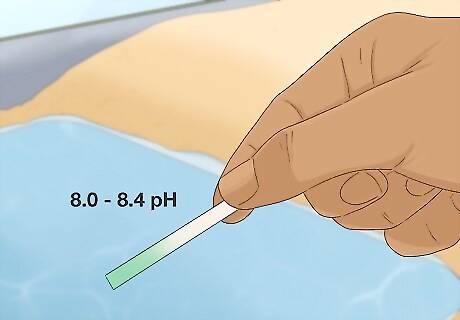
Keep the water pH between 8.0 and 8.4. Hermit crabs need to be in water with a similar pH to the ocean, which averages about 8.1. Dip pH paper in the water daily to check the levels. To increase pH, add 1 teaspoon (4.9 mL) of baking soda for every 5 gallons (19 L) of water. To decrease pH, add peat moss. When lowering the pH, add a small amount of peat moss to your filter, then test your water after a day. There’s no formula for adding moss to water, so test and check until you’re at your desired pH. Peat moss changes the pH gradually, so wait between additions.

Test your water for nitrite and ammonia regularly. Dip ammonia testing papers into the water regularly to make sure levels are undetectable. Similarly, use nitrate strips to make sure levels are less than 10 ppm (parts per million). To lower the levels, do a partial water change in your tank. Use a siphon to take 25-30% of the water out, then change it with new, clean, saltwater. Keep checking the levels until the ammonia is undetectable and nitrate is less than 10 ppm.
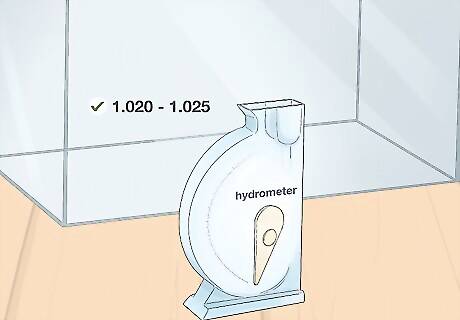
Adjust the specific gravity of the water so it's between 1.020 and 1.025. To mimic your hermit crab’s native environment, make the water the same specific gravity as the ocean. When gravity levels are too high, add a small amount of freshwater at a time to lower it. When they’re too low, slowly add saltwater. To keep your crabs safe, don't alter specific gravity more than 0.001 per day. Test the gravity by pouring a sample of water into a container and dropping in a hydrometer. Once it stops floating, check the waterline and read the corresponding specific gravity. Generally, a mix of 1 US gal (3.8 L) of freshwater to 8 tbsp (17.07 g) of marine salt will yield the correct gravity. Hydrometer scales read "specific gravity," which is the ratio of the liquid's density to the water's density. Make replacement water the same temperature as aquarium water. Measure your water when it’s a 77 °F (25 °C) for the most accurate reading.
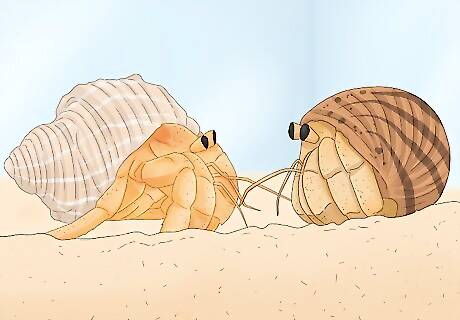
Add compatible fish and more crabs! Hermit crabs are social creatures that are used to hanging out with hundreds of fellow crustaceans. To keep them happy, add a few friends (of the same species) to the tank. Hermit crabs can live with fish, as long as they have the same temperature, pH, etc., needs. Good fish to add to your tank are clownfish, damselfish, gobies, wrasses, and cardinalfish. Steer clear of bettas, goldfish, and cichlids.
Hermit Crab Diet
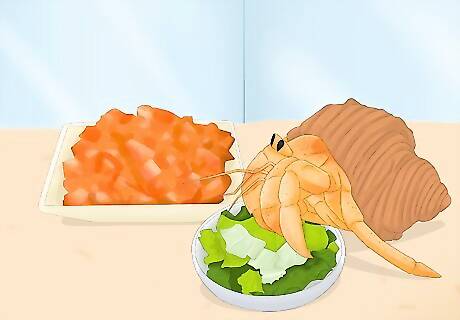
Feed your hermit crabs dark vegetables, meats, chopped fruit, and seeds. Hermit crabs require a very diverse diet—they cannot live on commercial foods alone. They require six food groups: proteins/lipids, calcium, carbohydrates, chitin, carotenoids, and omega fats. Offer them a mix of these groups every night. For protein, crabs like beef, chicken, pork—basically any meat you can eat. You can serve meat raw or uncooked, but always cook seafood to prevent any chance of disease. This is the most important food group, as it helps with molting and energy and prevents cannibalism. If your crabs are fighting, they may not be getting enough protein. Crabs can get calcium from okra, oyster shells, mealworms, egg shells, and dried shrimp. Carbohydrate-rich foods that hermit crabs enjoy are grapes, apples, grains, bananas, and seaweed. Chitin makes up your crabs' exoskeletons, and they can get it from exoskeletons…of other crabs! Lobster, shrimp, and crawfish are also good sources of chitin, just boil everything until it’s completely cooked, first. Carotenoids are found in dark green vegetables, leaves, bark, and moss. Cook your greens before feeding your crabs or their calcium absorption will be blocked. Coconuts, walnuts, olive oil, coconut oil, and fish skin all contain omega fats. Green sand and worm castings are also important parts of your crab’s daily diet.
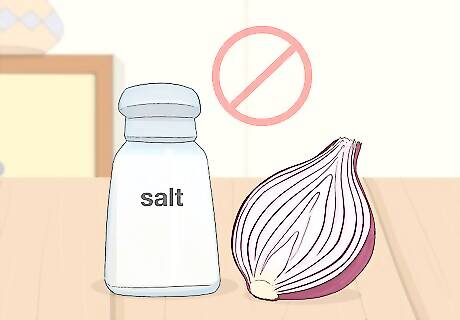
Don’t give your crabs butter, spices, salt, or onions. Hermit crabs have delicate digestive systems that can’t handle all the food ours can! If you buy any premade food from the store for them, check to be sure it is completely free of additives, including sauces. Onions, garlic, uncooked leafy greens, canola oil, and all spices and herbs should be left out of dinner. Uncooked leafy greens block calcium absorption.
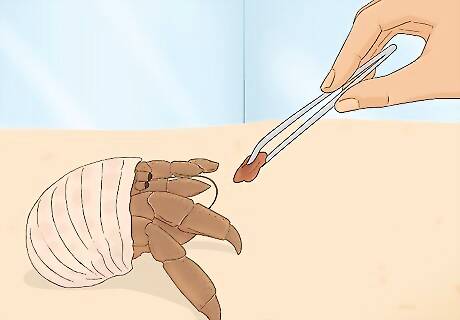
Feed marine crabs with tweezers, and give land crabs shallow dishes. To be sure your marine hermit crabs eat, offer each piece of food to them with tweezers. For land crabs, give them a shallow food dish that they can easily climb in and out of. Offer a small amount of food at a time to prevent them from overeating. Small marine crabs can live off of algae and fish refuse, but larger ones need to be fed. Both kinds of crabs require a balance of the same food groups. Always place meat into the habitat at night and remove it in the morning to prevent flies or scavengers. For marine hermit crabs, remove uneaten food an hour after feeding.



















Comments
0 comment